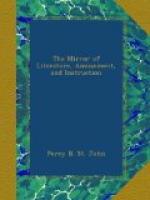“Where dwelt the muses at their natal hour;”
leaving to the less sensitive reviewers to prove, whether he had been “led astray by the light from heaven, or by his own clouded and tempestuous genius:”
“That fire within so fiercely burned
That whence it came it soon returned.”
Maturin, though corrupted and enervated by the follies and dissipation of the anti-poetic city, becoming, in his lucid intervals, “himself again,” in the composition of a splendid dramaticle.—Henry Neele, the “martyr-student,” inviting us to share in the intense admiration of intellect; forcibly demonstrating “that song is but the eloquence of truth”—but of him no more!
“The churchyard bears an added stone;
The fireside shows a vacant chair.”
Yet, however splendid the galaxy of literary stars may be, which illumine our Annuals, they owe no little of their lustre to the engravings. It fortuitously happens that we have not “a connoisseuring eye,” or we should swell this paper beyond the limits prescribed by editorial complaisance, in the pages of “THE MIRROR.” We are not ignorant, however, of the incomparable advancement which the science of engraving has made in the lapse of the last ten years; or how far it has left behind those mere scratches of the graver which lit up our young admiration when a boy. Two of these we will be impertinent enough to criticise, in spite of the affection with which we cherish the visionary recollection of the pictures of grandmother’s parlour. The subjects were “courtship,” and “matrimony.” In the former, the Chesterfieldian lover was seen handing his chere amie (a lusty wench, with red ochre cheeks) over a remarkably low stile: whether the subject, or the manner of its execution had inspired the muse, is no matter; but beneath was the following:—
“In courtship, Strephon careful
hands his lass
Over a stile a child with ease might pass”
The next was “matrimony;” but, oh! “look on this picture and on this!” The careless husband, forgetting his capacious spouse, leaves her to scramble over a stile of alarming altitude, whilst his attention seems absorbed in the quarrel of two snarling terriers. Such conjugal uncourtliness elicits its merited censure in the cool satire of the accompanying motto:—
“But wedded Strephon now
neglects his dame:
Tumble or not, to him ’tis all the
same.”
The costume of these two figures was in accordance with the date of the hey-day of Ranelagh Gardens; and the outline of the foliage was about on a par with those designs we often see cut out of paper, by an ingenious schoolboy yet they may be adduced as criterions of the average merit appertaining to the generality of the productions of the burine of “the old school.”
In closing this erratic dissertation on the Annuals, we may remark, that an interesting article might be written, descriptive of the reformation which gradually elevated the art of engraving to perfection—a history of its emerging from the inanities which flaunt in the window of Carver and Bowles, in St. Paul’s Churchyard, and arriving at the exquisite perfection of such achievements as “Alexander’s Visit to Diogenes,” and “Quintus Curtius leaping into the Gulf.”




